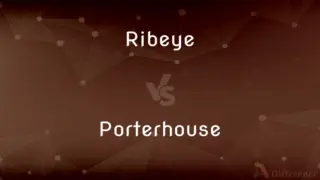Skirting vs. Baseboard — What's the Difference?
By Maham Liaqat & Urooj Arif — Updated on March 11, 2024
Skirting is a protective and decorative feature applied at the bottom of walls. Baseboard, primarily a North American term, refers to the specific type of skirting used for interior design.

Difference Between Skirting and Baseboard
Table of Contents
ADVERTISEMENT
Key Differences
Skirting, a term commonly used outside North America, serves both a protective and decorative function along the bottom edge of a wall. Baseboard, on the other hand, is the North American equivalent, focusing on the interior aspect, offering a clean transition between wall surfaces and flooring.
While skirting can be made from various materials including wood, PVC, and MDF, it's designed to protect walls from wear and furniture marks. Baseboards, while similar in function, often emphasize aesthetic appeal and are typically made from wood or MDF, painted or stained to complement interior decor.
The design and profile of skirting can vary widely, from simple and flat to ornate and detailed, depending on architectural styles. Baseboards tend to have a consistent profile within North American homes, focusing on simplicity and functionality, although they can also feature more elaborate designs in traditional or luxurious settings.
Installation methods for skirting can differ based on the material and design, requiring specific tools and techniques for fitting, especially in older or custom homes. Baseboards are usually easier to install, with standard sizes and profiles that fit most modern construction methods.
Despite the differences, both skirting and baseboards serve to cover the joint between the wall and the floor, providing a finished look and protecting the wall from damage. The choice between the two often comes down to regional terminology and the specific design preferences or requirements of a project.
ADVERTISEMENT
Comparison Chart
Terminology
Commonly used outside North America.
Primarily used in North America.
Function
Protective and decorative.
Decorative, with a focus on interior design.
Material Variety
Wood, PVC, MDF, and others.
Often wood or MDF.
Design Diversity
Ranges from simple to ornate.
Generally simpler, but can be elaborate.
Installation
May require specific tools/techniques.
Typically easier, with standard sizes and profiles.
Compare with Definitions
Skirting
Applied in various architectural styles, from modern to traditional.
They chose a simple, white skirting to match the minimalist aesthetic of their home.
Baseboard
A type of trim that covers the lowest part of an interior wall, offering a clean transition between wall and floor.
The new baseboard was painted white to contrast beautifully with the dark hardwood floors.
Skirting
A decorative feature at the bottom of walls, protecting against damage and hiding gaps.
The Victorian home featured ornate skirting that added to its historic charm.
Baseboard
Commonly made from wood or MDF, designed to match or accent interior styling.
The oak baseboard added warmth and natural texture to the room.
Skirting
Available in a wide range of materials to suit different needs and preferences.
For the bathroom, they selected PVC skirting to withstand humidity.
Baseboard
Installation is typically straightforward, fitting well with modern construction practices.
The contractor installed the baseboard quickly, using standard tools.
Skirting
Enhances the room's appearance by providing a finished look.
Installing skirting in the living room gave it a more polished and complete appearance.
Baseboard
Can be customized with paint or stain to align with the room's color scheme.
They decided to stain the baseboard to match the furniture, tying the room's design together.
Skirting
Can be used for both exterior and interior wall finishes.
The exterior skirting was added to protect the base of the home from moisture.
Baseboard
Primarily serves an aesthetic purpose, enhancing interior decor.
They chose a tall baseboard with intricate detailing to complement the room's grandeur.
Skirting
The part of a garment, such as a dress or coat, that hangs freely from the waist down.
Baseboard
In architecture, a baseboard (also called skirting board, skirting, wainscoting, mopboard, floor molding, or base molding) is usually wooden or vinyl board covering the lowest part of an interior wall. Its purpose is to cover the joint between the wall surface and the floor.
Skirting
A garment hanging from the waist and worn especially by women and girls.
Baseboard
A molding that conceals the joint between an interior wall and the floor. Also called mopboard.
Skirting
One of the leather flaps hanging from the side of a saddle.
Baseboard
A panel or molding between the floor and the interior wall of a structure
Skirting
The lower outer section of a rocket vehicle.
Baseboard
(US) A similar panel at the base of a piece of furniture or equipment.
Skirting
A flexible strip hanging from the base of an air-cushion vehicle.
Baseboard
A board, or other woodwork, carried round the walls of a room and touching the floor, to form a base and protect the plastering; - also called washboard (in England), mopboard, and scrubboard.
Skirting
A piece of fabric that extends over or beyond something to afford protection.
Baseboard
A molding covering the joint formed by a wall and the floor
Skirting
A spray skirt.
Skirting
An outer edge; a border or margin
A base camp on the skirt of the mountain.
Skirting
Offensive Slang A woman.
Skirting
To lie along or form the edge of; border
The creek that skirts our property.
Skirting
To pass around rather than across or through
Changed their course to skirt the storm.
Skirting
To pass close to; miss narrowly
The bullet skirted an artery.
Skirting
To evade, as by circumlocution
Skirted the controversial issue.
Skirting
To lie along, move along, or be an edge or a border.
Skirting
Present participle of skirt
Skirting
Skirting boards collectively.
Skirting
Skirts collectively; material for skirts
Skirting
The act of one who skirts around something, or avoids it.
Skirting
A skirting board.
Skirting
Skirts, taken collectivelly; material for skirts.
Skirting
Being all around the edges; enclosing;
His encircling arms
The room's skirting board needs painting
Common Curiosities
How does baseboard differ from skirting?
Baseboard, a specific type of skirting used in North America, focuses more on the interior decorative aspect and the transition between wall and floor.
What materials are commonly used for skirting and baseboards?
Both are often made from wood, MDF, or PVC, depending on durability needs and aesthetic preferences.
Can skirting and baseboards be customized?
Absolutely, they can be painted, stained, or cut to specific designs to match or enhance your decor.
Can baseboard be used as skirting?
Yes, baseboard is essentially the North American term for skirting, used specifically within interior design.
Is it necessary to have skirting or baseboards in a home?
While not structurally necessary, they are highly recommended for protecting walls, concealing uneven edges, and adding a finished look to rooms.
How does the installation of skirting and baseboards differ?
Installation varies based on the type and material, but baseboards typically have a more standardized fitting suitable for modern construction, while skirting might require custom fitting, especially in older homes or with elaborate designs.
Do skirting and baseboards need to match door trim?
For a cohesive look, it's often recommended but not strictly necessary. Matching style and color can unify a space.
Can I install skirting or baseboards myself?
Yes, with the right tools and some DIY knowledge, it's possible, though precision is key for a professional finish.
What is the primary purpose of skirting?
Skirting protects the bottom of walls from damage and hides gaps between walls and floors, also adding a decorative touch.
Do skirting and baseboards come in different styles?
Yes, both come in a range of styles from simple and flat to ornate, depending on the architectural and interior design.
How do you maintain skirting and baseboards?
Regular dusting and occasional cleaning with appropriate cleaners for the material will keep them looking fresh.
How do you choose the right skirting or baseboard for a room?
Consider the room’s style, the material’s durability, and whether the profile complements your interior design.
Are there any functional benefits to installing skirting or baseboards?
Beyond aesthetics, they protect walls from furniture scuffs, conceal wiring, and can help seal gaps to prevent drafts.
What is the average height of baseboards?
Baseboard height can vary, typically ranging from 3 to 8 inches, depending on ceiling height and aesthetic preference.
How often should skirting and baseboards be replaced or updated?
They last many years but might be updated for aesthetic reasons or replaced if damaged.
Share Your Discovery

Previous Comparison
Torte vs. Torta
Next Comparison
Pursue vs. PursuitAuthor Spotlight
Written by
Maham LiaqatCo-written by
Urooj ArifUrooj is a skilled content writer at Ask Difference, known for her exceptional ability to simplify complex topics into engaging and informative content. With a passion for research and a flair for clear, concise writing, she consistently delivers articles that resonate with our diverse audience.












































